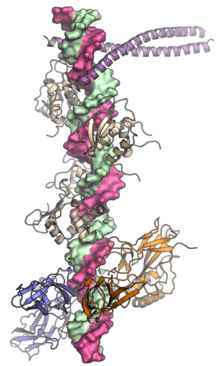Enhanceosome

The enhanceosome is a higher-order protein complex assembled at the enhancer and regulates expression of a target gene.[1] The binding and assembly of the activating proteins is cooperative due to energetically favorable protein-protein interactions formed in the complex.
The best known example of the enhanceosome acts on the human interferon-beta gene, which is upregulated in cells that are infected by viruses.[2] Three activator proteins—NF-κB, an interferon activator protein such as IRF-3, and the ATF-2/c-Jun complex—cooperatively bind to the upstream enhancer region upon viral infection. The interaction is mediated by a fourth protein HMG-I, which assists in stabilizing the complex by promoting inter-protein interactions. The assembled enhanceosome recruits transcriptional machinery such as RNA polymerase to the promoter region to initiate gene expression.[1][2]
References
- 1 2 Merika, M; Thanos, D (April 2001). "Enhanceosomes". Current Opinion in Genetics & Development. 11 (2): 205–8. doi:10.1016/s0959-437x(00)00180-5. PMID 11250145.
- 1 2 Panne, D (April 2008). "The enhanceosome". Current Opinion in Structural Biology. 18 (2): 236–42. doi:10.1016/j.sbi.2007.12.002. PMID 18206362.
External links
- Enhanceosome Molecule of the Month (February 2010) by David Goodsell